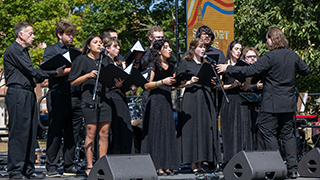Journalism Professor Receives NEH Grant for New Book Research
Wednesday, April 27th, 2022

Assistant Professor of Journalism Matthew Pressman, Ph.D., pictured here with his 2018 book, On Press: The Liberal Values That Shaped the News.
Matthew Pressman, Ph.D., assistant professor of journalism within the College of Communication and the Arts, has been awarded a Summer Stipend by the National Endowment for the Humanities for his project "A History of the New York Daily News and its Populist Politics."
The grant will enable Pressman to continue his archival research for this, his latest book project, and visit Northwestern University to study the papers of Robert McCormick (head of the Daily News's parent company, the Chicago Tribune Company, from 1919 until McCormick's death in 1954) and Stanton Cook (head of the Tribune Company in the 1970s and 80s). In addition, Pressman will visit Syracuse University to view the papers of Bill Gallo (a Daily News reporter and sports cartoonist from the 1940s to the 2000s) and Warren King (a Daily News editorial cartoonist from the 1950s to the 1970s).
Pressman notes that although the Daily News was the highest-circulation newspaper in American history, it has received scant attention from scholars. Every Sunday in the late 1940s, roughly 4.5 million people purchased a copy of the New York Daily News. It sold more than 2 million copies each weekday. No other newspaper in U.S. history ever came close to that enormous circulation.
While Pressman is still in the research phase of this project, he has already published work based on his findings to date.
In 2019, The Atlantic published his article about the similarities between the political positions of the mid-20th-century Daily News and those of Donald Trump. In "America's Biggest Newspaper 70 Years Ago Sounded a Lot Like Trump Today," Pressman writes
…the News' dominance was greatest in white, non-Jewish outer-borough neighborhoods such as Jamaica Estates, where the Trumps lived. Given that the man of the house, Fred C. Trump, was a major advertiser in the News and frequently appeared in its real-estate columns in the 1940s and '50s, young Donald might have encountered it regularly—and, though adult Donald may not realize the connection, he sounds eerily like it now.
Last year, his article "The New York Daily News and the History of Conservative Media" appeared in the journal Modern American History, which is published by Cambridge University Press.
In that article Pressman writes
From the 1940s through the 1960s, the Daily News attacked the same targets as [National Review founder William F.] Buckley and his compatriots: bureaucrats, diplomats, taxes, regulation, and, above all, communists and their supposed fellow travelers. But whereas National Review was intellectual and interventionist, the Daily News was populist and isolationist. This distinction makes the Daily News—and like-minded mass-circulation newspapers such as the Washington Times-Herald and much of the Hearst chain—all the more important to place within the history of conservative media. If one traces the evolution of post–World War II American conservatism from Barry Goldwater to Ronald Reagan to George W. Bush, it makes sense to pinpoint National Review as the journalistic parent of the movement. But if one considers a parallel lineage for American conservatism, running through such figures as Robert Taft, Joseph McCarthy, George Wallace, Rush Limbaugh, and Donald Trump, the Daily News of the mid-twentieth century makes a more fitting patriarch.
The new book, whose working title is The People's Paper: A History of the Daily News and Its Populist Politics, is expected to be completed in 2024.
Pressman's 2018 book, On Press: The Liberal Values That Shaped the News (Harvard University Press), received the 2019 PROSE Award from the Association of American Publishers. The book — which was featured in the Washington Post, Harvard University's NiemanLab, Politico and on CSPAN's "Book TV" — examines the historical underpinnings of the news media, exploring how journalism in the 1960s through the 1980s unveiled the characteristics of contemporary journalism recognizable today.
Categories: Arts and Culture






